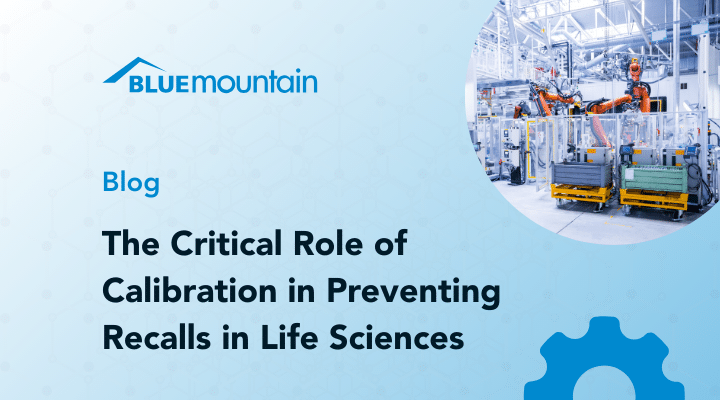Product recalls in the life sciences industry are not just operational disruptions—they’re costly, reputation-damaging, and potentially dangerous to patient health. As regulatory scrutiny grows and supply chains become increasingly complex, recalls have become more frequent and more expensive. On average, a pharmaceutical recall can cost between $8 million and $10 million, while medical device recalls range from $12 million to $30 million. Biologics and vaccines, which are particularly sensitive to environmental conditions, can exceed $50 million per recall. In extreme cases involving litigation or patient fatalities, costs can soar into the billions.
Given these stakes, life sciences manufacturers must prioritize quality and compliance at every level of production. One of the most fundamental, yet often overlooked, components of this quality ecosystem is calibration.
What Is Calibration in the GMP Environment?
Calibration is the process of comparing the measurements of equipment or instruments to a known, standardized value and making adjustments if needed. For life sciences manufacturers, this process ensures that all measurements used in product release, in-process control, and environmental monitoring are reliable and within specification, minimizing the risk of systematic errors that may impact product quality or patient safety.
From high-performance liquid chromatography (HPLC) machines in a lab to temperature sensors in cleanrooms and filling equipment on manufacturing lines, calibration is essential for ensuring data integrity and process reliability.
Why Calibration Helps Prevent Recalls
Recalls often stem from defects or deviations that could have been prevented with proper calibration. For example:
- Drug formulation errors can occur when balances and mixers are miscalibrated, leading to incorrect dosages.
- Sterilization processes rely on calibrated sensors to confirm proper temperature, pressure, and exposure times—key to ensuring product sterility.
- Labeling and packaging lines depend on correctly calibrated sensors to prevent mislabeling or incorrect expiration dates.
- Analytical testing can produce invalid results if lab instruments are out of spec, potentially releasing substandard products.
- Environmental controls must be accurately calibrated to maintain critical parameters in storage and production environments.
In short, calibration reduces variability, ensures consistent product quality, and directly mitigates the risk of recall-triggering failures.
Calibration: A Core Compliance Requirement
Regulatory agencies worldwide mandate calibration as part of Good Manufacturing Practices (GMP). Key regulations include:
- FDA 21 CFR Part 820 (Medical Devices)
- 21 CFR Part 211 (Pharmaceuticals)
- ISO 13485 (Medical Devices)
- ICH Q10 (Pharma Quality Systems)
- EU GMP Annex 11 (Computerized Systems)
Failure to comply with calibration standards often leads to FDA warning letters and can invalidate entire production batches—often necessitating costly recalls.
Real-World Consequences
In one notable example, an injectable drug was recalled after improperly calibrated filling equipment caused inconsistent dosages. The company faced a Class I recall—the most serious type—along with FDA inspection findings and millions in financial losses. Routine calibration could have prevented this entirely.
Conclusion
In the high-stakes world of life sciences manufacturing, calibration is not optional—it’s essential. A well-maintained calibration program ensures accurate measurements, supports regulatory compliance, and most importantly, protects patients. By investing in robust calibration protocols, companies can significantly reduce their risk of recalls—and the staggering costs that come with them.

